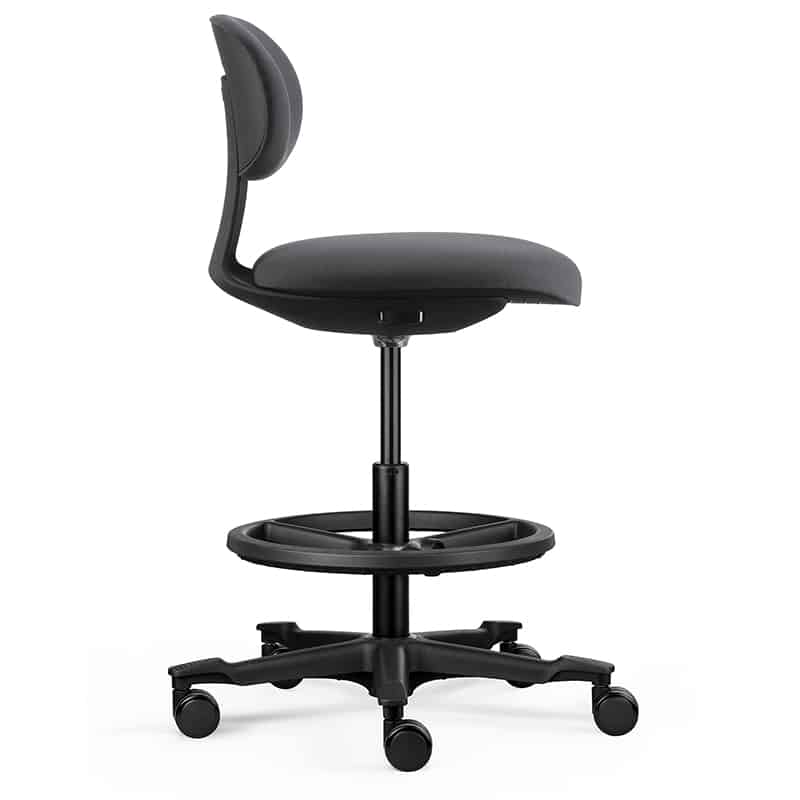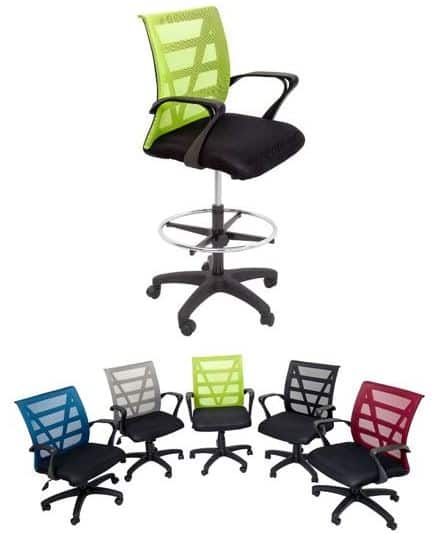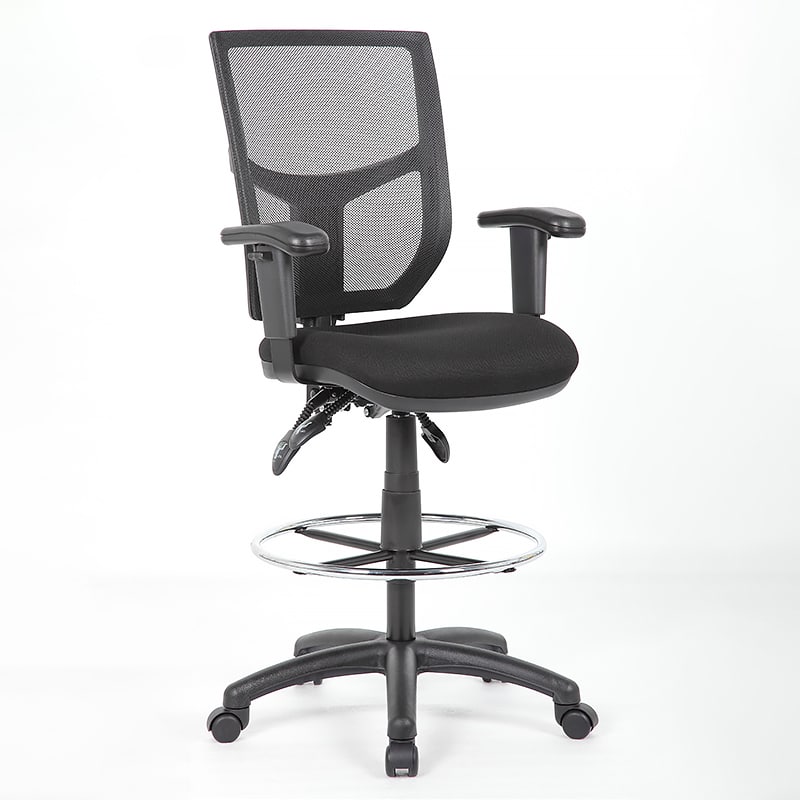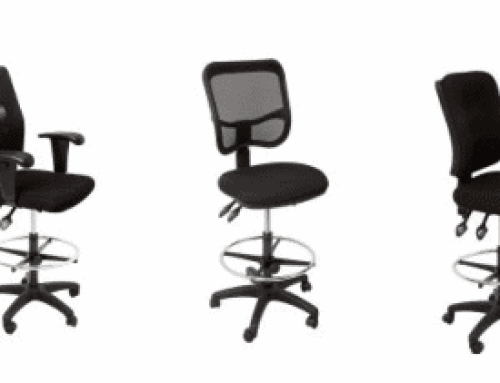Drafting chairs bridge the gap between comfort, functionality, and style in the workplace. Whether you’re an architect, designer, engineer, or someone who uses elevated work surfaces, the role of drafting chairs in improving posture and productivity cannot be overstated. Unlike conventional office chairs, drafting chairs are tailored for unique workstations that require a higher vantage point and greater adaptability.
This guide covers everything you need to know about drafting chairs, including their features, benefits, and why investing in the right one is essential for your workspace.
What is a Drafting Chair?
A drafting chair is a type of seating designed for use on elevated surfaces, such as drafting tables and standing desks. These chairs feature adjustable heights, footrests, and ergonomic structures that offer comfort during extended work hours.
Drafting stools are often equipped with swivel functions, lumbar support, and other ergonomic features, catering to professionals across industries. From architectural studios to creative workspaces, drafting chairs strike a balance between functionality, comfort, and style.
Key Features of Drafting Chairs

1. Adjustable Height
The defining feature of drafting chairs is their ability to adjust to high work surfaces. Whether you’re sketching at a drafting table or working on plans at an elevated desk, the adjustable height function ensures your comfort and alignment.
2. Integrated Footrests
Drafting chairs typically come with a footrest or foot ring, allowing users to support their feet when seated at higher levels comfortably. This feature reduces strain on the legs and encourages better posture.
3. Ergonomic Design
Ergonomics is at the heart of drafting chairs. Lumbar support, padded seats, and backrests make these chairs an excellent choice for professionals who spend long hours seated. An ergonomic drafting chair helps reduce discomfort and minimise the risk of back pain.
4. Swivel and Tilt Functionality
Many drafting chairs feature a swivel base and adjustable tilt, offering flexibility and ease of movement. Whether you need to turn or recline slightly, these features enhance comfort and make it more adaptable.
5. Durability and Style
Drafting chairs are made from durable materials to withstand the rigorous demands of professional workspaces. With sleek designs and premium finishes, these chairs not only perform well but also elevate the aesthetics of your space.
Why You Need a Drafting Chair
Drafting chairs aren’t just for architects or engineers. They’re versatile seating options suitable for anyone working at an elevated height or standing desk. Here are the key reasons to invest in a drafting stool or chair for your workspace.
1. Enhanced Comfort
Traditional chairs fall short when paired with high work surfaces. Drafting chairs fill this gap by offering tailored support for elevated desks, ensuring you can work comfortably for hours.
2. Improved Posture
Many professionals overlook the impact of bad posture on their health. An ergonomic drafting chair promotes correct alignment, reducing strain on your spine, shoulders, and neck.
3. Versatility
Drafting chairs aren’t restricted to professional studios. They’re also great for home offices, laboratories, or art spaces. Their adaptability allows them to fit a variety of work environments seamlessly.
4. Compatibility with Standing Desks
With the rising popularity of standing desks, drafting chairs provide an excellent companion for those who toggle between sitting and standing during their workday. Adjustable heights and footrests make transitioning effortless.
5. Boosted Productivity
Comfortable seating leads to better focus and efficiency. A high-quality drafting stool minimises distractions caused by discomfort, allowing you to focus entirely on your tasks.
Choosing the Right Drafting Chair for You

1. Assess Your Workspace Requirements
Before making a purchase, evaluate your workspace setup. Do you use a standing desk or an extra-tall drafting table? Knowing your specific needs will help you find the right drafting chair with optimal height adjustment capabilities.
2. Prioritise Ergonomic Features
Look for chairs with built-in lumbar support, cushioned seats, and adjustable backrests for maximum comfort. Ergonomics is essential, especially for prolonged usage.
3. Check the Weight Capacity
Ensure the chair you choose supports your weight and maintains stability during use. Durable materials and sturdy frames are essential for long-term reliability.
4. Opt for Durability and Style
Drafting chairs are meant to withstand daily wear and tear. Choose models made from robust materials, such as steel frames and leather seats. If aesthetics are important, view drafting chairs with modern designs to complement your space.
5. Consider Additional Features
Extra features, such as swivel bases, footrest adjustments, and breathable mesh backs, enhance the chair’s functionality and make your workday easier.
Best Drafting Chairs for Different Environments
1. Drafting Chairs for Architects and Designers
Architects and designers need flexibility and comfort. Chairs with high adjustability, tilting mechanisms, and padded support are ideal for these fields.
2. Drafting Stools for Laboratories
For professionals working in labs, drafting stools with easy-to-clean materials and compact designs are the perfect fit. These stools allow for better movement and accessibility in confined spaces.
3. Drafting Chairs for Artists
Artists benefit from chairs with swivel functions and tall backs. Breathable materials are also ideal, ensuring comfort during long creative sessions.
4. Drafting Stools for Home Offices
Home offices gain a professional touch with ergonomic drafting chairs. Compact models with stylish designs pair well with home decor and standing desks.
5. Drafting Chairs for Commercial Workspaces
Corporate environments benefit from drafting chairs with polished designs and advanced ergonomic features. Combining elegance with practicality, they make a great addition to professional office spaces.
Drafting Chairs vs. Traditional Office Chairs
1. Design and Height
While traditional chairs are designed for standard desk heights, drafting chairs cater to elevated surfaces and standing desks. Their height adjustment feature sets them apart from regular seating options.
2. Ergonomic Support
Both office chairs and drafting chairs prioritise comfort, but drafting chairs take it a step further with features like footrests and advanced height adjustments.
3. Functionality
Drafting chairs are versatile and can be adjusted to accommodate both seated and standing positions. Traditional office chairs lack this dual functionality.
4. Application
Traditional office chairs are ideal for standard desks, while drafting stools are better suited for specialty workstations, such as drafting tables and tall counters.
FAQs about Drafting Chairs
1. What is a drafting chair used for?
Drafting chairs are used on elevated surfaces, such as drafting tables, standing desks, and counters. They provide the necessary height, support, and comfort for professionals who work at these higher workstations.
2. Are drafting chairs suitable for standing desks?
Yes, drafting chairs pair perfectly with standing desks. Their adjustable heights and footrests make them an excellent option for alternating between sitting and standing.
3. How do I find the best ergonomic drafting chair?
Look for features like lumbar support, padded seats, adjustable armrests, and a footrest. These ergonomic elements ensure comfort and reduce strain during long working hours.
4. What’s the difference between a drafting stool and a drafting chair?
Drafting stools are typically simpler, with fewer ergonomic features, while drafting chairs include backrests, armrests, and enhanced lumbar support for extended comfort.
5. Can drafting chairs be used in home offices?
Absolutely! Drafting chairs are a versatile choice for home offices, particularly when paired with a standing desk or elevated table.
Drafting chairs are a worthwhile investment for anyone who works with an elevated desk or drafting table. Whether you need enhanced ergonomics, flexible height adjustments, or sleek designs, drafting chairs cater to a variety of needs while improving comfort and productivity.
When shopping for the perfect option, view drafting chairs with advanced features like lumbar support, footrests, and durable materials. From artists and architects to professionals using standing desks, drafting chairs are designed to elevate your workspace and streamline your workflow. Choose the right chair today and experience the difference it can make in your daily routine!



